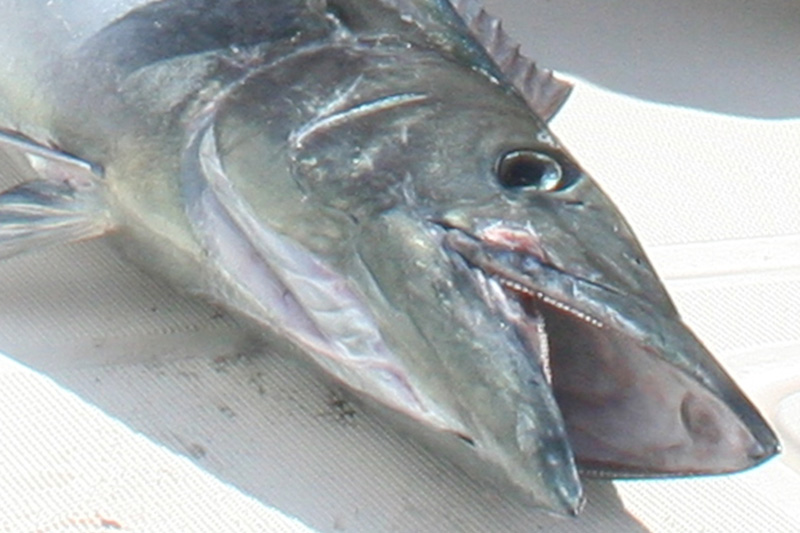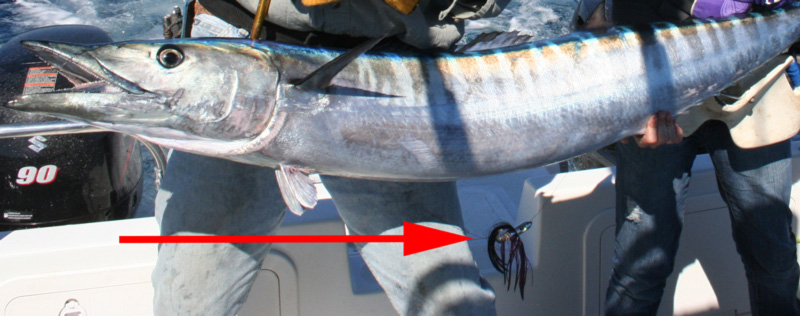As fall approaches and the wahoo bite picks up at Mid-Atlantic hotspots like the Oceanic Deli many offshore anglers are looking forward to shots at these toothy but tasty critters. Do you know how to get these silver bullets biting? Getting some lures down deep is a big part of this game, but there are other tricks to try as well. These top tactics will do the trick.

Deploy a planer to get lures running well below the surface. Not in-line planes, though, because you’ll often be trolling too fast for these to be effective. A Zwing planer run off a stern cleat, commonly known as a “poor man’s downrigger,” usually works far better. Rig 60 feet of 300-pound test to the Zwing, with a loop at the other end. Set the planer out at a dead idle, and put the loop around a stern cleat. Then kick it up to trolling speed, let out 25 to 30 feet of line on a baited rig, and bend a rubber band around the main line. Loop the ends of the rubber band back through the ring of a snap swivel, then clip the other end of the swivel around the planer line. Then, put the reel into freespool. Water pressure will draw the line and swivel down the planer line until the swivel hits the planer itself, and your bait’s then running down deep. When a fish hits, it’ll snap the rubber band and you can fight the fish without any added weight or tension.
Add a two- to four-pound sash weight in-line. You’ll need a seriously stout rod for this to take up the tension of all that weight, and to light tackle aficionados this is no fun at all. But it works. Most anglers use a short, broomstick-thick dredge rod and a reel spooled with at least 80-pound test for the task. That line, however, shouldn’t be mono. Between the stretch and the thick diameter it’s the worst choice for this sort of set-up. Many anglers use braid, and some even prefer to use steel or monel wire for their weighted wahoo lines.
Employ a downrigger. But it can’t be just any old downrigger, because at the seven or eight mph speeds you troll for wahoo at the cable will hum and vibrate, and the ball may not go deep enough due to all the water resistance. Heavy braid, however, will cut the water and eliminate vibrations. Remember, however, that this can put a ton of stress on your downrigger. Only use topnotch units for this because among the cheaper models, snapping them or breaking mounts is not unheard-of.
Reach for a high-speed diving plug. Lipped lures usually can’t handle fast trolling speeds, but swimming/diving plugs like Yo-Zuri Bonitas and MagBays will dig down without spinning or rolling. Caution is in order, however – keep swimming plugs far away from other deep lines, because if they end up getting tangled you’re in for a seriously huge mess.
Put some dark colors into the mix. For some reason, wahoo are partial to very dark color patterns. Black/red, purple/black, orange/black, and similar mixes often draw their attention before common bright offshore colors like greens, pinks, and blues. In fact, a ballyhoo skirted in black/red is one of the most effective offerings around when wahoo are the target. Also try putting a spoon into the mix. Spoons may be the ultimate in low-tech, but they’re also some of the most under-rated lures on the face of the planet – and that includes when you’re fishing for wahoo. But don’t put back a plain silver or gold. Spoons with color prism tape, again in those dark patterns with reds and purples, are often the best pick.

Ignore all of the above, and instead try high-speed wahoo trolling. In this case, you’ll need to eliminate the planers or downriggers, plugs, and spoons. Stick with weighted braid or wire lines, and use bullet-head lures with weight in the nose (no plungers or chuggers, which will often come flying out of the water at high speeds). Kick the throttles up until you’re doing 12 to 14 mph. Use this tactic when you’re really not sure where the fish are located, since you can cover huge amounts of ground in very little time. That said, at these speeds hooking into other species becomes rare; there’s a very good chance that using this method you’ll either catch wahoo or nothing at all. So if you have a good idea of where the fish have been and there may also be species like tuna or mahi around, trolling at a more “regular” pace is often the better move.
Rig with wire leader. Wahoo have some serious teeth and can bite through just about any mono leader light enough to slide through a Sea Witch. Note that after each and every hook-up, those wire leaders need to be checked for kinks. If you find any, re-rig before setting it back or you’ll likely end up breaking the next fish off.
Look for scattered weeds and puffer fish. Odd as it may sound, wahoo will chow down on schools of puffers found near the surface in and amongst scattered patches of sargassum during the fall months. Trolling through scattered weeds can be difficult and requires you to constantly check both your lines and planer or downrigger lines to be sure they haven’t become fouled, but if you don’t troll where the fish are you aren’t likely to catch many.
Remember people, catching wahoo off the DelMarVa coast is no easy feat. Three or four strikes in a day is a banner bite, they have a well-developed habit of pulling the hook at boat-side, and gaffing fish with their long, skinny profile is exceedingly difficult. But once you slap some ‘hoo steaks on the grill you’ll realize that the fall bite is one you don’t want to miss — and hopefully these tricks will help make your next voyage a success.